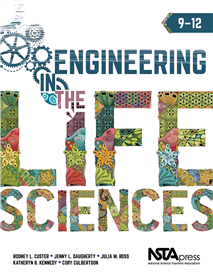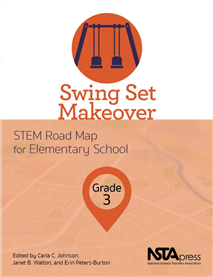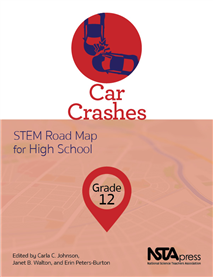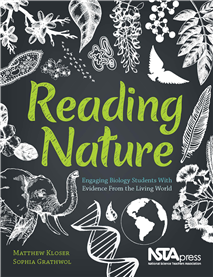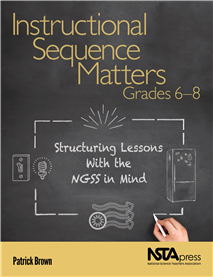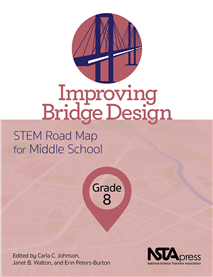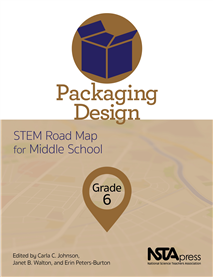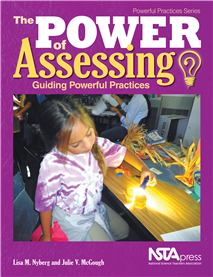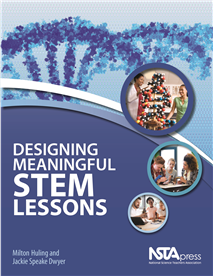All Book Chapters
Book Chapter
This lesson asks students to engage in a series of activities to understand the relationship among photosynthesis, respiration, carbon dioxide (CO2), and human impact on the environment. The purpose is to have students design, evaluate, and refine a ...
Book Chapter
This lesson asks students to develop strategies for matching genetic characteristics with environmental conditions to optimize the growth of the Pacific yew tree, which is a threatened species. Student teams will propose and analyze a breeding progra...
Book Chapter
This lesson asks students to develop a synthetic genetic code to minimize the change in amino acid sequence in a protein due to mutations, within given criteria and constraints. Students compile and analyze data for their synthetic genetic code model...
Book Chapter
This lesson asks students to consider the aspects of cell cycle regulation and feedback as they propose a mechanism to stop cancerous cell division with the strategic use of cell cycle regulators. The purpose of designing a cancer treatment protocol ...
Book Chapter
This lesson asks students to explore the positive and negative factors affecting ecosystems and their impact on either an endangered species or an invasive species. Student teams first conduct research on the real-life challenges. Next, the teams des...
Book Chapter
This chapter contains five engineering case studies. Each one presents an engaging story of how engineering was used to find a solution to a real-world problem or opportunity. The stories were chosen to span a range of science and engineering fields....
Book Chapter
Swing Set Makeover, Grade 3: STEM Road Map for Elementary School (Book sample chapter)
What if you could challenge your third graders to design a swing set that’s safe but still lots of fun? With this volume in the STEM Road Map Curriculum Series, you can!Swing Set Makeover outlines a journey that will steer your students toward auth...
Book Chapter
Technological Advances in Automobiles
In this lesson, students are introduced to and experiment with mousetrap cars and the science and industry of crash testing cars with a focus on safety improvements. Students investigate the history of technologies that have allowed cars to achieve g...
Book Chapter
In this lesson, students use the law of conservation of momentum and energy to investigate the forces and motions involved in three scenarios—a car striking a stationary object, two vehicles colliding head-on, and two vehicles colliding at an angle...
Book Chapter
In this lesson, students investigate the history of safety features in cars and apply this understanding to a question that has existed since the origination of civil society—Under what conditions should governments establish rules for safety that ...
Book Chapter
Reading Nature: Engaging Biology Students With Evidence From the Living World (Book Sample)
By making room for this book in your curriculum, you’ll have a fresh way to motivate your students to look at the living world and ask not only “Why?” but also “How do we know?” Unique in both its structure and approach, Reading Nature is a...
Book Chapter
Instructional Sequence Matters, Grades 6–8: Structuring Lessons With the NGSS in Mind (Book Sample)
Instructional Sequence Matters shows how to make simple shifts in the way you arrange and combine activities to improve student learning. It also makes it easy for you to put the NGSS into practice. After explaining why sequencing is so important, au...
Book Chapter
Engineering in the Life Sciences, 9–12 (Book Sample)
When the authors of this book took part in Project INFUSE, the National Science Foundation–funded teacher development program, they noticed something. Life science teachers were highly receptive to engineering ideas related to everything from genom...
Book Chapter
Modern Sequences of Instruction
This chapter discusses the key components of two contemporary sequences of science instruction. It presents the phases of the POE (Predict, Observe, and Explain) and 5E (Engage, Explore, Explain, Elaborate, and Evaluate) Instructional Models. The act...
Book Chapter
Content and Process Working Together
This chapter describes the construction of the Next Generation Science Standards (NGSS). The author shares some activities for you to reflect on lessons you currently use and the connection to components of the NGSS. By cultivating a way of thinkin...
Book Chapter
Investigating Change Using the Invisible Test Tube Demonstration
Chapters 6–9 share model lessons for putting the explore-before-explain mindset into practice using either a POE (Predict, Observe, and Explain) or 5E (Engage, Explore, Explain, Elaborate, and Evaluate) instructional sequence. In this chapter, the ...
Book Chapter
There’s More to Magnetism Than Certain Objects Being Attracted to Refrigerators
Chapters 6–9, share model lessons for putting the explore-before-explain mindset into practice using either a POE (Predict, Observe, and Explain) or 5E (Engage, Explore, Explain, Elaborate, and Evaluate) instructional sequence. This chapter explore...
Book Chapter
Making the Connection: Addressing Students’ Misconceptions of Circuits
Chapters 6–9 share model lessons for putting the explore-before-explain mindset into practice using either a POE (Predict, Observe, and Explain) or 5E (Engage, Explore, Explain, Elaborate, and Evaluate) instructional sequence. In this chapter, st...
Book Chapter
Chapters 6–9 share model lessons for putting the explore-before-explain mindset into practice using either a POE (Predict, Observe, and Explain) or 5E (Engage, Explore, Explain, Elaborate, and Evaluate) instructional sequence. This chapter offers a...
Book Chapter
Leadership Can Make the Difference
This chapter takes you through five key lessons to putting an explore-before-explain mindset into practice using POE (Predict, Observe, and Explain) and 5E (Engage, Explore, Explain, Elaborate, and Evaluate) instructional sequences that incorporate t...
Book Chapter
Car Crashes, Grade 12: STEM Road Map for High School (Book Sample)
What if you could challenge your 12th graders to understand car crashes in the context of physical forces, manufacturing challenges, government safety standards, and individual rights? With this volume in the STEM Road Map Curriculum Series, you can!...
Book Chapter
In this lesson, students explore the state of infrastructure in the United States. Using bridges as a lens, they are presented with the challenge of developing a decision model for the local department of transportation. In the process of developing ...
Book Chapter
In this lesson, students take a closer look at beam bridges—one of the earliest forms of bridge construction—and the most common design. As they explore the basics of beam bridges, they experiment, collect data, and write functions that model the...
Book Chapter
In this lesson, students explore arch bridges—one of the earliest bridge designs—and because of its beauty and strength, a design that has stood the test of time. Through experimentation, students investigate strength, span length, and overall st...
Book Chapter
Suspension and Cable-Stayed Bridges
In this lesson, students explore the last two bridge designs— the suspension bridge and the cable-stayed bridge. While these bridges both use cables to support the road deck, they do so in different ways. Through research and experimentation, stude...
Book Chapter
Bridges can have a major impact on the people and communities. In this lesson, students explore some of the economic impacts bridges have had in our society. In mathematics, students will be presented with four plans that describe the initial and fut...
Book Chapter
Putting It All Together–Decision Models
In this lesson, students will use the knowledge they have gained through their research, investigations, and classroom discussions to compare and contrast strength, span length, structure, and function of the four bridge designs explored in this modu...
Book Chapter
This lesson introduces the module and the Product Design Challenge. It engages students with packaging by asking them to respond to a display of products and consider the appeal of the packaging to buyers. It also provides students with the opportuni...
Book Chapter
In this lesson, students continue to prepare for their Product Design Challenge by building background knowledge required to complete the project. This includes exploring three dimensional shapes, calculating surface area and volume, and learning abo...
Book Chapter
Marketing Your Product in a Global Economy
In this lesson, students learn about the marketing profession and world economy. They continue to explore how marketing influences consumers. Students work in groups to design and present a marketing plan for the team’s product, which includes logo...
Book Chapter
Why Is Assessing a Powerful Teaching Tool?
Authentic assessments shine a light on learning for both students and teachers! Assessments allow students and teachers to reflect on and celebrate successes along the learning journey while engaging in questioning, investigating, and assessing as a ...
Book Chapter
How Do I Design Authentic Assessments to Meet the Needs of ALL Learners?
Students need opportunities to show what they know in a variety of ways and at multiple points along the way. Knowing what to look for and how to interpret what you see may guide you to plan new experiences. Questioning, investigating, and assessing ...
Book Chapter
How Does Metacognition Support Instructional Decision Making?
Metacognition engages students and teachers in reflection of the learning process—in essence, thinking about thinking. Metacognitive questions give teachers a better understanding of how students are processing content, the types of connections the...
Book Chapter
Improving Bridge Design, Grade 8: STEM Road Map for Middle School (Book Sample)
What if you could challenge your eighth graders to strengthen the nation’s infrastructure by designing bridges that last longer? With this volume in the STEM Road Map Curriculum Series, you can! Improving Bridge Design outlines a journey that wi...
Book Chapter
The Power of Assessing: Guiding Powerful Practices (Book sample chapter)
The Power of Assessing will show you how to use authentic assessments as a dynamic teaching tool. But this book doesn’t just describe ways to evaluate your students’ learning. Through colorful photographs and over 30 minutes of video footage you ...
Book Chapter
Packaging Design, Grade 6: STEM Road Map for Middle School (Book Sample)
Packaging Design outlines a journey that will steer your students toward authentic problem solving while grounding them in integrated STEM disciplines. As are the other volumes in the series, this book is designed to meet the growing need to infuse r...
Book Chapter
This chapter features Earth and Space science StEMT lessons. For this disciplinary core idea, we chose a simple lesson focused on soils and the role soils play in plant growth. The lesson starts with students being asked questions about what plants ...
Book Chapter
Introducing a New and Urgent Case for STEM Education
Doing STEM does not need to be difficult for teachers. By helping teachers understand the method for StEMTifying their existing lessons and turning them into STEM lessons, engineering becomes another tool that is helpful and beneficial for students....
Book Chapter
A New Way of Thinking About STEM
Chapters 5 and 6 are included in this book selection. Chapter 5 focuses on StEMT, our way of making sense of STEM as a process. We are not out to challenge the acronym but when you see this term, it is to guide you to a new way of thinking about STEM...
Book Chapter
This chapter features Earth and Space science StEMT lessons. The engineering design challenge calls for students to develop a technology to separate the materials in a mixture. Devising a means of separation for each type of material will expose stud...



